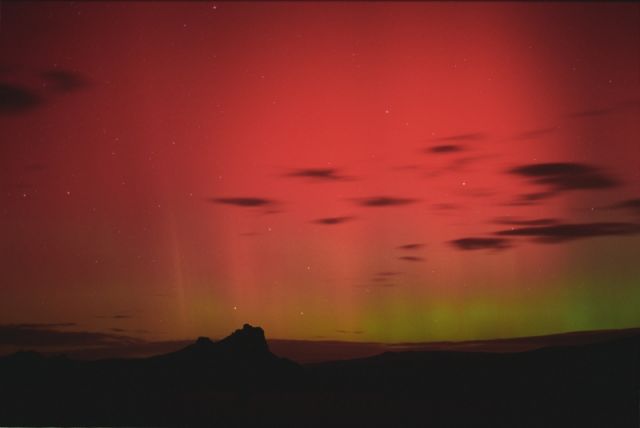Credit & Copyright: Jimmy Westlake
(Colorado
Mountain College)
Explanation:
Vivid
auroral displays
were triggered by a cloud of
high energy
particles from the Sun that collided with planet
Earth's
magnetosphere
yesterday, October 29, at about 06:30
Universal Time.
The collision was anticipated, following an
intense
solar flare
and coronal mass ejection detected on October 28, and many
anxious skywatchers were rewarded with an enjoyable light show.
While aurorae don't normally
haunt skies in the southern United
States, they were reported
from locations in Missouri, Texas,
New Mexico, and California in the early morning hours.
Near Yampa, Colorado astronomer Jimmy Westlake also spent
early yesterday morning enjoying the stormy
space weather.
He was impressed by this
colorful apparition of
the northern lights -- produced by excited
oxygen and nitrogen atoms interacting with energetic electrons
at altitudes of 100 kilometers or more.
Brighter stars shine through the extreme high-altitude
glow which shows much lower clouds
and the distant horizon in silhouette.
1999 2000 2001 2002 2003 2004 2005 2006 2007 2008 2009 2010 2011 2012 2013 2014 2015 2016 2017 2018 2019 2020 2021 2022 2023 2024 2025 |
Yanvar' Fevral' Mart Aprel' Mai Iyun' Iyul' Avgust Sentyabr' Oktyabr' Noyabr' Dekabr' |
NASA Web Site Statements, Warnings, and Disclaimers
NASA Official: Jay Norris. Specific rights apply.
A service of: LHEA at NASA / GSFC
& Michigan Tech. U.
|
Publikacii s klyuchevymi slovami:
aurora - solar flare - polyarnoe siyanie - Solnechnaya vspyshka
Publikacii so slovami: aurora - solar flare - polyarnoe siyanie - Solnechnaya vspyshka | |
Sm. takzhe:
Vse publikacii na tu zhe temu >> | |
